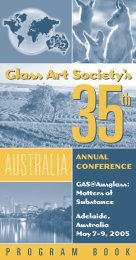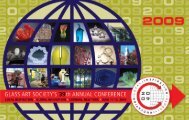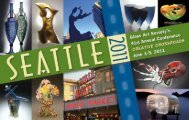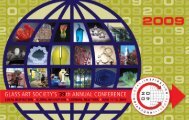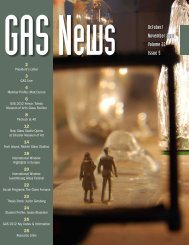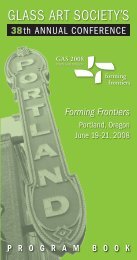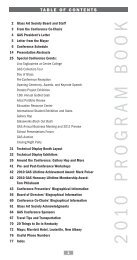letter from the GAs President Get ready to be ... - Glass Art Society
letter from the GAs President Get ready to be ... - Glass Art Society
letter from the GAs President Get ready to be ... - Glass Art Society
You also want an ePaper? Increase the reach of your titles
YUMPU automatically turns print PDFs into web optimized ePapers that Google loves.
M E M B E R P R O F I L E<br />
J. P. Canlis<br />
Rich Wren "Flesh"<br />
S T U D E N T P R O F I L E<br />
Rich Wren<br />
by Andrew Erdos<br />
Rich Wren, tat<strong>to</strong>oed back<br />
Rich Wren is a Philadelphia based artist whose work is not limited <strong>to</strong> glass. He often<br />
crosses boundaries <strong>be</strong>tween sculpture, two-dimensional art and body modification.<br />
Many of Wren’s pieces refer <strong>to</strong> his experience as a tat<strong>to</strong>o artist and his interest in<br />
<strong>the</strong> human body. The identity of <strong>the</strong> body, writing on <strong>the</strong> body, and <strong>the</strong> message sent <strong>to</strong><br />
o<strong>the</strong>rs through imagery permanently im<strong>be</strong>dded in<strong>to</strong> human flesh is depicted with many<br />
mediums. He explains, “The images I create on glass and steel are quite similar <strong>to</strong> <strong>the</strong>se<br />
actions. The image is an act, a reaction or a memory.”<br />
The piece “Flesh” embodies <strong>the</strong>se intentions. The title provokes psychological<br />
associations of a raw, primal nature, and Christianity. As Wren descri<strong>be</strong>s it “The bread<br />
<strong>be</strong>fore <strong>the</strong> glass cross has a duality of <strong>be</strong>ing one’s own body and Christ’s body (sinner<br />
and saint). Flesh is a shrine and an altar, <strong>to</strong> <strong>the</strong> divinity of self, and <strong>to</strong> <strong>the</strong> mortality of<br />
mankind.”<br />
Wren is also well-versed in Judo and a small circle form of Aikido called Aiki-jui-jitsu.<br />
This experience with circular motions and <strong>the</strong> use of staff like weapons has helped him<br />
understand many of <strong>the</strong> fine details in glass blowing. The Jo staff is approximately <strong>the</strong><br />
same length as most blowpipes and punties, and aspects such as balance and centering<br />
draw parallels <strong>be</strong>tween <strong>the</strong> ancient art of glassblowing and <strong>the</strong>se ancient martial arts.<br />
Wren has <strong>be</strong>en practicing Aiki-jui-jitsu and Judo for approximately nine years, and<br />
has <strong>be</strong>en teaching it for four years. He has over five years of experience as a tat<strong>to</strong>o artist<br />
and currently works at <strong>the</strong> Inkwell outside of Philadelphia. Wren <strong>be</strong>gan working with<br />
glass at Bucks County Community College. This spring he will <strong>be</strong> Graduating <strong>from</strong> Tyler<br />
School of <strong>Art</strong>. Examples of his work can <strong>be</strong> found in <strong>the</strong> Temple University Collection,<br />
<strong>the</strong> Magellan Logistics Collection, and permanently em<strong>be</strong>dded in people’s flesh across<br />
<strong>the</strong> country.<br />
Andrew Erdos is a student at Alfred University will <strong>be</strong> graduating spring 2007. He has<br />
<strong>be</strong>en operating a small lampworking studio in New<strong>to</strong>wn, Pennsylvania since winter 2004.<br />
He has work in <strong>the</strong> private collections of Mr. and Mrs. Michelle Guggenheim and Junior<br />
Marvin (guitar player for Bob Marley and <strong>the</strong> Wailers).<br />
For Jean-Pierre (J.P.) Canlis, simplicity and completion are <strong>the</strong> most important<br />
elements of his work. As he explains, “Anyone can make something simple<br />
seem complex; it is taking <strong>the</strong> complex and translating it in<strong>to</strong> <strong>the</strong> most simple<br />
form which inspires me. I want <strong>the</strong> viewer <strong>to</strong> walk away settled, feeling <strong>the</strong> art<br />
has a sense of completion.” His pieces resonate with this purity, exposing <strong>the</strong><br />
essence of <strong>the</strong> organic elements that Canlis captures in his work.<br />
Canlis’ signature has <strong>be</strong>come his unique bamboo installations. Whe<strong>the</strong>r<br />
<strong>the</strong>y are mounted on a wall of a <strong>be</strong>droom or 3D in a hotel, <strong>the</strong> original works<br />
make an impact. The solid sculpted glass stalks of <strong>the</strong>se installations can <strong>to</strong>wer<br />
up <strong>to</strong> twelve feet high.<br />
The natural forces of <strong>the</strong> ocean are <strong>the</strong> inspiration for Canlis’ series of work,<br />
“Ocean Studies.” An avid surfer who spent his childhood in Hawaii, Canlis has a<br />
keen under-standing of <strong>the</strong> ocean’s movement, currents, and waves, which he<br />
explores in <strong>the</strong> six different forms of his “Ocean Studies” series.<br />
Canlis first picked up a glassblowing pipe in 1991 at Hawaii’s Punahou<br />
School and later studied glass art at Alfred University in New York and <strong>the</strong><br />
Pilchuck School in Washing<strong>to</strong>n. After Martin Blank introduced J.P. <strong>to</strong> Chihuly in<br />
1993, J.P. spent <strong>the</strong> next nine years working in Chihuly’s hot shop. During his last<br />
fours years with Chihuly, Canlis also worked with Lino Tagliapietra’s glass team.<br />
In 1996, Canlis created <strong>the</strong> company Jean-Pierre Canlis <strong>Glass</strong>, now known as<br />
Canlis <strong>Glass</strong>.<br />
In 2005, after working exclusively on Canlis <strong>Glass</strong> in Honolulu for four<br />
years, J.P. moved back <strong>to</strong> Seattle <strong>to</strong> set up Canlis <strong>Glass</strong> Gallery & Studio in<br />
down<strong>to</strong>wn Seattle with his wife and business partner, Leigh Canlis. J.P.’s works<br />
are on view in restaurants, hotels, and corporations throughout <strong>the</strong> United<br />
States. His latest works are available for viewing at Canlis <strong>Glass</strong> Gallery in <strong>the</strong><br />
Northwest Worklofts, 3131 Western Avenue, Suite 329, Seattle, WA 98121.<br />
Also visit www.canlisglass.com.<br />
Right: J.P. Canlis<br />
Above:<br />
Canlis’ Bamboo series (detail)<br />
3



